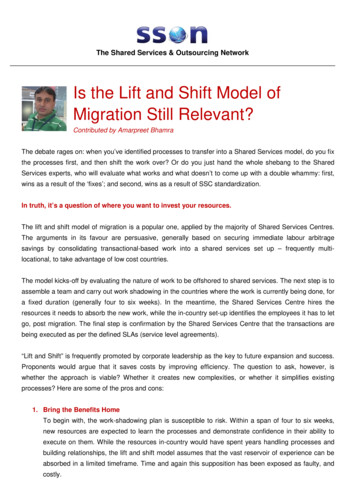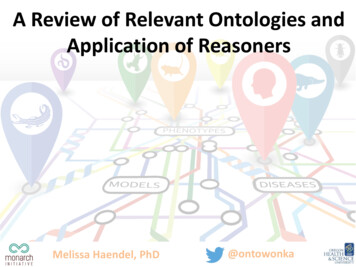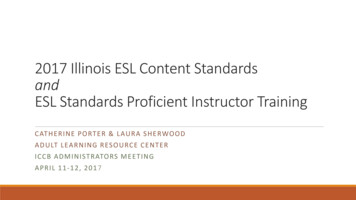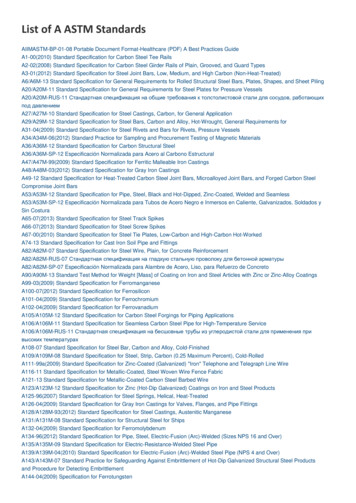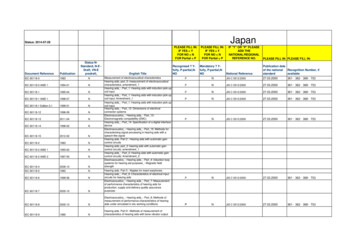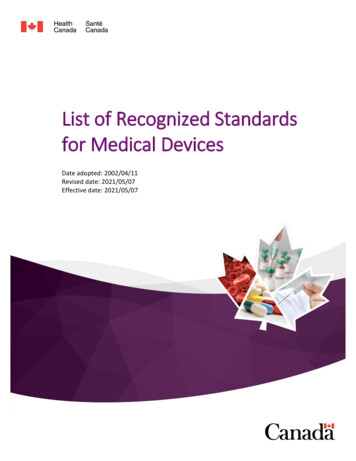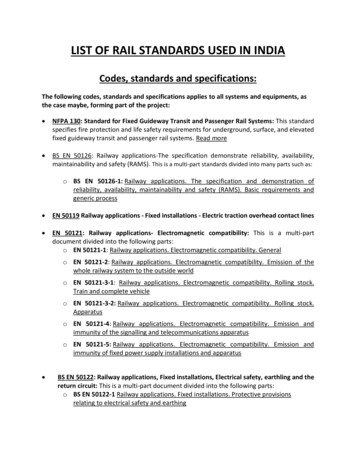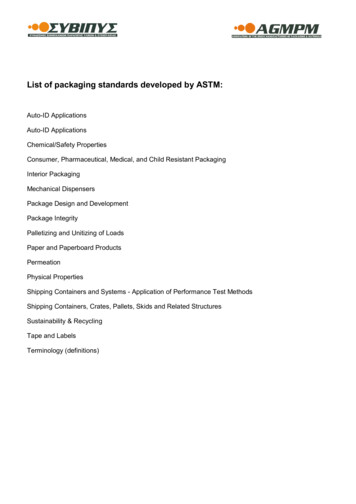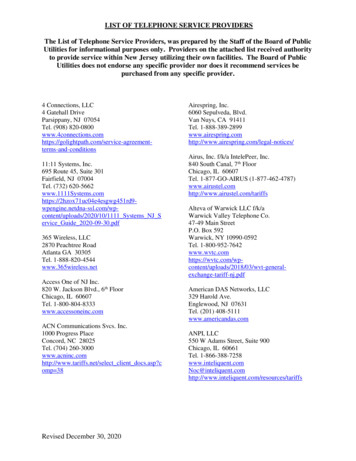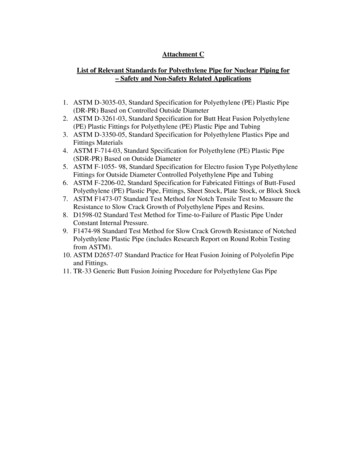
Transcription
Attachment CList of Relevant Standards for Polyethylene Pipe for Nuclear Piping for– Safety and Non-Safety Related Applications1. ASTM D-3035-03, Standard Specification for Polyethylene (PE) Plastic Pipe(DR-PR) Based on Controlled Outside Diameter2. ASTM D-3261-03, Standard Specification for Butt Heat Fusion Polyethylene(PE) Plastic Fittings for Polyethylene (PE) Plastic Pipe and Tubing3. ASTM D-3350-05, Standard Specification for Polyethylene Plastics Pipe andFittings Materials4. ASTM F-714-03, Standard Specification for Polyethylene (PE) Plastic Pipe(SDR-PR) Based on Outside Diameter5. ASTM F-1055- 98, Standard Specification for Electro fusion Type PolyethyleneFittings for Outside Diameter Controlled Polyethylene Pipe and Tubing6. ASTM F-2206-02, Standard Specification for Fabricated Fittings of Butt-FusedPolyethylene (PE) Plastic Pipe, Fittings, Sheet Stock, Plate Stock, or Block Stock7. ASTM F1473-07 Standard Test Method for Notch Tensile Test to Measure theResistance to Slow Crack Growth of Polyethylene Pipes and Resins.8. D1598-02 Standard Test Method for Time-to-Failure of Plastic Pipe UnderConstant Internal Pressure.9. F1474-98 Standard Test Method for Slow Crack Growth Resistance of NotchedPolyethylene Plastic Pipe (includes Research Report on Round Robin Testingfrom ASTM).10. ASTM D2657-07 Standard Practice for Heat Fusion Joining of Polyolefin Pipeand Fittings.11. TR-33 Generic Butt Fusion Joining Procedure for Polyethylene Gas Pipe
An American National StandardDesignation: D 3035 – 03Standard Specification forPolyethylene (PE) Plastic Pipe (DR-PR) Based on ControlledOutside Diameter1This standard is issued under the fixed designation D 3035; the number immediately following the designation indicates the year oforiginal adoption or, in the case of revision, the year of last revision. A number in parentheses indicates the year of last reapproval. Asuperscript epsilon (e) indicates an editorial change since the last revision or reapproval.This standard has been approved for use by agencies of the Department of Defense.1. Scope1.1 This specification covers polyethylene (PE) pipe madein thermoplastic pipe dimension ratios based on outside diameter and pressure rated for water (see Appendix X1). Includedare criteria for classifying PE plastic pipe materials and PEplastic pipe, a system of nomenclature for PE plastic pipe, andrequirements and test methods for materials, workmanship,dimensions, sustained pressure, burst pressure, and environmental stress cracking. Methods of marking are also given.1.2 All pipes produced under this specification may be usedfor the transport of water, industrial process liquids, effluents,slurries, municipal sewage, etc. The user should consult themanufacturer to determine whether the material being transported is compatible with polyethylene pipe and will not affectthe service life beyond limits acceptable to the user.1.3 The values stated in inch-pound units are to be regardedas the standard. The values given in parentheses are forinformation only.1.4 The following safety hazards caveat pertains only to thetest methods portion, Section 7, of this specification: Thisstandard does not purport to address all of the safety concerns,if any, associated with its use. It is the responsibility of the userof this standard to establish appropriate safety and healthpractices and determine the applicability of regulatory limitations prior to use.D 1505 Test Method for Density of Plastics by the DensityGradient Technique3D 1598 Test Method for Time-to-Failure of Plastic PipeUnder Constant Internal Pressure4D 1599 Test Method for Short-Time Hydraulic Failure Pressure of Plastic Pipe, Tubing, and Fittings3D 1600 Terminology for Abbreviated Terms Relating toPlastics3D 1603 Test Method for Carbon Black in Olefin Plastics3D 2122 Test Method for Determining Dimensions of Thermoplastic Pipe and Fittings3D 2290 Test Method for Apparent Tensile Strength of Ringor Tubular Plastics and Reinforced Plastics by Split DiskMethod3D 2837 Test Method for Obtaining Hydrostatic DesignBasis for Thermoplastic Pipe Materials3D 3350 Specification for Polyethylene Plastics Pipe andFittings Materials3F 412 Terminology Relating to Plastic Piping Systems32.2 NSF International Standards:ANSI/NSF Standard No. 14 for Plastic Piping Componentsand Related Materials5ANSI/NSF Standard No. 61 for Drinking Water SystemComponents—Health Effects52.3 PPI Documents:TR-4 Listing of Hydrostatic Design Bases (HDB), StrengthDesign Bases (SDB), Pressure Design Bases (PDB) andMinimum Required Strength (MRS) Ratings for Thermoplastic Piping Materials or Pipe6TR-9 Recommended Design Factors for ThermoplasticPressure Pipe62. Referenced Documents2.1 ASTM Standards:D 618 Practice for Conditioning Plastics and ElectricalInsulating Materials for Testing2D 792 Test Method for Density and Specific Gravity (Relative Density) of Plastics by Displacement3D 1238 Test Method for Flow Rates of Thermoplastics byExtrusion Plastometer33. Terminology3.1 Definitions—Definitions are in accordance with Terminology F 412, and abbreviations are in accordance with Terminology D 1600, unless otherwise specified.1This specification is under the jurisdiction of ASTM Committee F17 on PlasticPiping Systems and is the direct responsibility of Subcommittee F17.26 on OlefinBased Pipe.Current edition approved Sept. 10, 2003. Published November 2003. Originallyapproved in 1972. Last previous edition approved 2001 as D 3035 – 01.2Annual Book of ASTM Standards, Vol 08.01.3Annual Book of ASTM Standards, Vol 08.03.4Annual Book of ASTM Standards, Vol 08.04.Available from the National Sanitation Foundation, P.O. Box 1468, Ann Arbor,MI 48106.6Available from the Plastics Pipe Institute, Inc., 1825 Connecticut Ave., NW,Suite 680 Washington, DC 20009.5Copyright ASTM International, 100 Barr Harbor Drive, PO Box C700, West Conshohocken, PA 19428-2959, United States.1
D 3035 – 03manufactured from plastic compounds meeting the materialrequirements of this specification and ( 2) the strength anddesign requirements are calculated on the same basis as thoseused in this specification.3.2 Definitions of Terms Specific to This Standard:3.2.1 hydrostatic design stress— the estimated maximumtensile stress in the wall of the pipe in the circumferentialorientation due to internal hydrostatic water pressure that canbe applied continuously with a high degree of certainty thatfailure of the pipe will not occur.3.2.2 pressure rating (PR)—the estimated maximum pressure that water in the pipe can exert continuously with a highdegree of certainty that failure of the pipe will not occur.3.2.3 relation between dimension ratio, hydrostatic designstress, and pressure rating—the following expression, commonly known as the ISO equation,7 is used in this specificationto relate dimension ratio, hydrostatic design stress, and pressure rating:2S/P 5 R21 or 2S/ P 5 D0/t! 2 1where:S P D0 t R 5. Materials5.1 Classification—Polyethylene compounds suitable foruse in the manufacture of pipe under this specification shall beclassified in accordance with Specification D 3350 and asshown in Table 1.NOTE 1—Piping intended for use in the transport of potable watershould be evaluated and certified as safe for this purpose by a testingagency acceptable to the local health authority. The evaluation should bein accordance with requirements for chemical extraction, taste, and odorthat are no less restrictive than those included in ANSI/NSF Standard No.14 or ANSI/NSF Standard No. 61. The seal or mark of the laboratorymaking the evaluation should be included on the piping.NOTE 2—Pipe users should consult with the pipe manufacturer aboutthe outdoor exposure life of the product under consideration.(1)hydrostatic design stress, psi (MPa),pressure rating, psi (MPa),average outside diameter, in. (mm)minimum wall thickness, in. (mm), and,thermoplastic pipe dimension ratio (D0/ t for PEpipe).5.2 Long-term Property Requirements—Polyethylene compounds suitable for use in the manufacture of pipe under thisspecification shall meet or exceed the long-term propertyrequirements in Table 2.5.3 HDB Listing—Polyethylene compounds suitable for usein the manufacture of pipe under this specification shall belisted in PPI TR-4 with HDB ratings in accordance with Table2.5.4 Rework Material—Clean, rework material having thesame classification and generated from the manufacturer’s ownpipe production, may be used by the same manufacturer, aslong as the pipe produced meets all of the requirements of thisspecification.3.2.4 thermoplastic pipe dimension ratio (DR)—the ratio ofpipe diameter to wall thickness. For PE pipe covered by thisspecification it is calculated by dividing the average outsidediameter of the pipe, in inches, by the minimum wall thickness,in inches. If the wall thickness calculated by this formula is lessthan 0.062 in. (1.6 mm), it shall be arbitrarily increased to0.062 in.3.2.5 thermoplastic pipe materials designation code—thepolyethylene pipe materials designation code shall consist ofthe abbreviation PE for the type of plastics, followed by theASTM grade in Arabic numerals and the hydrostatic designstress in units of 100 psi with any decimal figures dropped.Where the hydrostatic design stress code contains less than twofigures, a zero shall be used before the number. Thus, acomplete material code shall consist of two letters and fourfigures for PE plastic pipe materials (see Section 5).6. Requirements6.1 Workmanship—The pipe shall be homogeneousthroughout and free from visible cracks, holes, foreign inclusions, or other defects. The pipe shall be as uniform ascommercially practicable in color, opacity, density, and otherphysical properties.6.2 Dimensions and Tolerances:6.2.1 Outside Diameters—The outside diameters and tolerances shall be as shown in Table 3 when measured in4. Pipe Classification4.1 General—This specification covers PE pipe made fromthree PE plastic pipe materials in various dimension ratios andwater pressure ratings.4.2 Thermoplastic Pipe Dimension Ratios (DR)—Thisspecification covers PE pipe in various dimension ratios suchas, but not limited to, DR 11, DR 13.5, DR 17, and DR 21. Thepressure rating is uniform for all nominal sizes of pipe for agiven PE pipe material and DR. (See Table X1.1.)4.3 Special Sizes—Where existing system conditions orspecial local requirements make other diameters or dimensionratios necessary, other sizes or dimension ratios, or both, shallbe acceptable in engineered products when mutually agreedupon by the customer and manufacturer if (1) the pipe isTABLE 1 Specification D 3350 Cell Classifications forPolyethylene Pipe MaterialsPE Material Designation CodePhysical Property:DensityMelt IndexFlexural ModulusTensile Strength at YieldSlow Crack Growth ResistanceHydrostatic Design BasisColor and UV StabilizerCAPE 1404PE 2406PE 340812311A1CCell Classifications23 or 43 or 43 or 46B3C or E33 or 44 or 54 or 56B4C or ETest Method D 1693 ESCR.Test Method F 1473 PENT.CClassification E compounds shall have sufficient UV stabilizer to protect pipefrom deleterious effects due to continuous outdoor exposure during shipping andunprotected outdoor storage for up to 18 months. Pipe produced from Classification E compounds is not suitable for continuous use in exposed outdoor applications. Classification C and E compounds shall have sufficient antioxidants to meetrequirements in Specification D 3350. Classification C compounds shall contain 2to 3 % carbon black when tested in accordance with Test Method D 1603.B7ISO R 161-1960, Pipes of Plastics Materials for the Transport of Fluids(Outside Diameters and Nominal Pressure), Part 1, Metric Series.2
D 3035 – 03TABLE 2 Long-Term Property RequirementsPE MaterialDesignation CodeLong-term Property in Accordancewith Test Method D 2837APE 1404PE 2406PE 3408PE 2406 and PE 3408HDB of 800 psi at 73 F (5.52 MPa at 23 C)HDB of 1250 psi at 73 F (8.62 MPa at 23 C)HDB of 1600 psi at 73 F (11.03 MPa at 23 C)Minimum HDB of 630 psi at 140 F (4.34 MPa at 60 C)PE 3408 when tested in accordance with Test Method D 2290,Procedure B and 7.7. The failure shall be ductile.6.4 Sustained Pressure at Ambient and ElevatedTemperature—Pipes made from PE 2406 and PE 3408 shall betested in accordance with 7.7 at the pressures and temperaturesspecified in Table 7. Tests may be conducted at either stress andon any size, but tests conducted on 6 in. (168 mm) nominal sizepipe shall be considered representative of all pipe sizes. Ifductile failures occur at the higher stress, repeat testing at thelower stress.AThe hydrostatic design basis shall be established using water or air as thepressurizing fluid.TABLE 3 Outside Diameters and Tolerances for DR-PR PEPlastic PipeNominal PipeSize, in.Outside Diameter,in. (mm)Tolerances,in. (mm) 111 411 22346810121416182022240.840 (21.34)1.050 (26.7)1.315 (33.4)1.660 (42.2)1.900 (48.3)2.375 (60.3)3.500 (88.9)4.500 (114.3)6.625 (168.28)8.625 (219.08)10.750 (273.05)12.750 (323.85)14.000 (355.60)16.000 (406.40)18.000 (457.20)20.000 (508.00)22.000 (558.80)24.000 (609.60)60.004 (0.10)60.004 (0.10)60.005 (0.13)60.005 (0.13)60.006 (0.15)60.006 (0.15)60.008 (0.20)60.009 (0.23)60.011 (0.28)60.013 (0.33)60.015 (0.38)60.017 (0.43)60.063 (1.60)60.072 (1.83)60.081 (2.06)60.090 (2.29)60.099 (2.51)60.108 (2.74)12347. Test Methods7.1 Conditioning—Condition the test specimens for not lessthan 40 h prior to test in accordance with Procedure A ofPractice D 618, for those tests where conditioning is required.7.2 Test Conditions—Conduct tests in the standard laboratory atmosphere of 73 6 3.6 F (23 6 2 C), unless otherwisespecified in the test methods or in this specification.7.3 Sampling—The selection of the sample or samples ofpipe shall be as agreed upon by the purchaser and the seller. Incase of no prior agreement, random samples as selected by thetesting laboratory shall be deemed adequate.7.4 Ambient Temperature Sustained Pressure Test—Selectsix specimens of pipe at random and
1. ASTM D-3035-03, Standard Specification for Polyethylene (PE) Plastic Pipe (DR-PR) Based on Controlled Outside Diameter 2. ASTM D-3261-03, Standard Specification for Butt Heat Fusion Polyethylene (PE) Plastic Fittings for Polyethylene (PE) Plastic Pipe and Tubing 3. ASTM D-3350-05, Standard Specification for Polyethylene Plastics Pipe and


